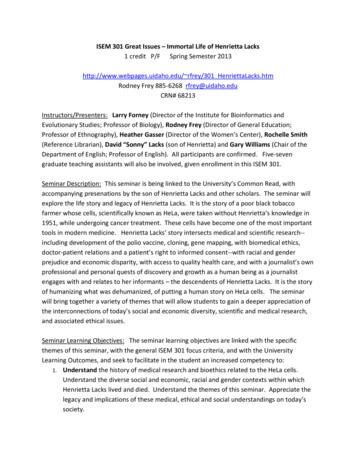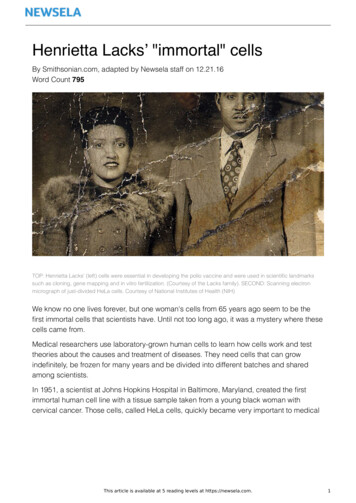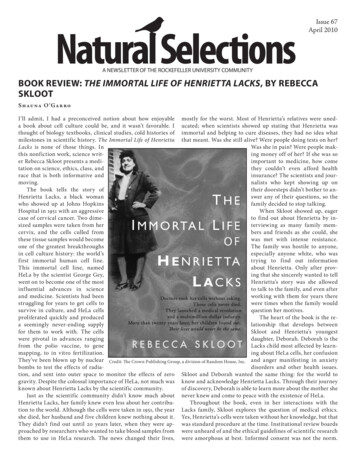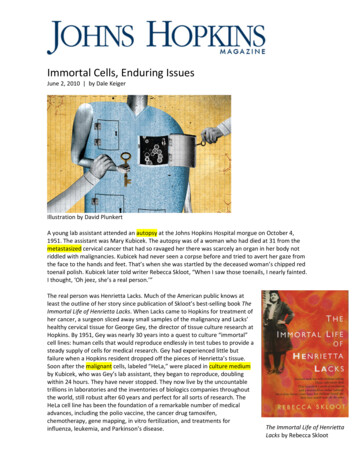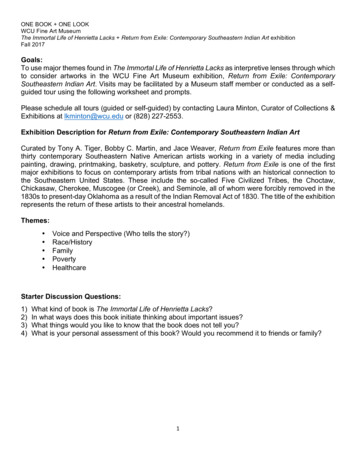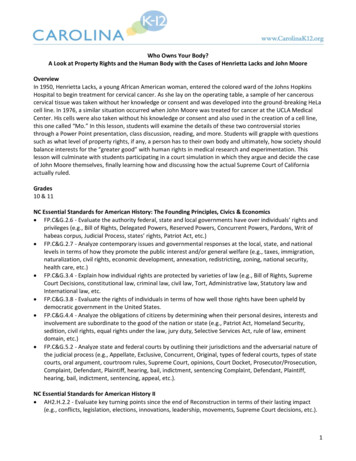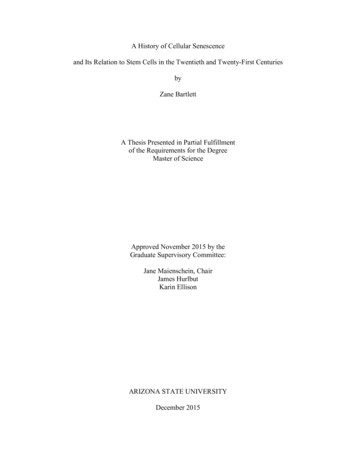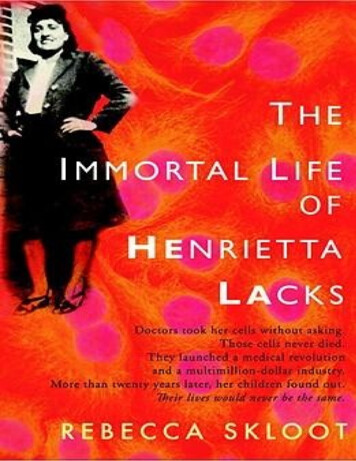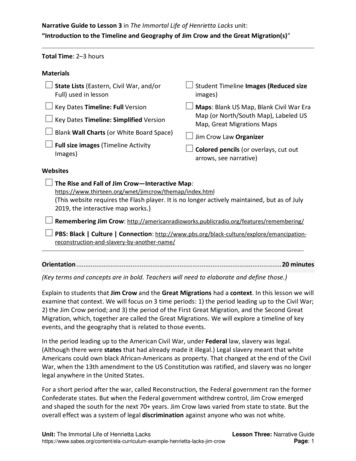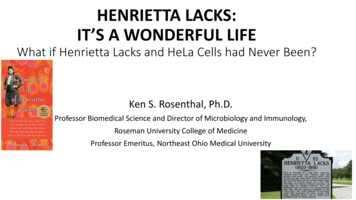
Transcription
HENRIETTA LACKS:IT’S A WONDERFUL LIFEWhat if Henrietta Lacks and HeLa Cells had Never Been?Ken S. Rosenthal, Ph.D.Professor Biomedical Science and Director of Microbiology and Immunology,Roseman University College of MedicineProfessor Emeritus, Northeast Ohio Medical University
Jimmy Stewart’s character, GeorgeBailey, in “It’s A Wonderful Life”,declared that he wished that he neverexisted.What if Henrietta Lacks never existed?
https://www.youtube.com/watch?v IYYUn83xzwA6:30-7:30 minutes
What if?What if Henrietta Lacks never existed?What if Henrietta Lacks never got infected with human papilloma virus 18What if Henrietta Lacks never got cervical carcinoma?What if her physician, Howard W. Jones, at Johns Hopkins never took abiopsy? What if Dr. George Otto Gey never put her biopsy cells into cell culture? What if Dr. Gey never shared the cells with others? What if the ATCC and other companies never made the HeLa cells availablefor scientific use?
Lots of Scientists Use HeLa Cells in ResearchNumber of publications using different cell lines as of 2010https://www.wired.com/2010/01/st henrietta/
What are HeLa cells? The first human cell that could be grownin tissue culture without senescence. Epithelial cells, representative of a majortype of human cell. HeLa is a model cell for many normalbiochemical functions. HeLa is a ‘transformed’ cell and is amodel for cancer cells, with differencesfrom normal cells. HeLa is infected with HPV18 HeLa is a model for how HPV 18 causescells to lose growth control and have thepotential to become a cancer.
Benefits from HeLa Virology Viruses can be easily grown in HeLa. To study how they replicate. To produce large quantities of virus. HeLa is infected with Human papillomavirus 18 How and Why? How to treat? Cell Biology Structure and function of human cells Structure and function of human cancer cells Effect of drugs and other molecules on human cells Vaccines Early polio vaccines Large quantity of virus for vaccine Large quantity of virus to use in challenge studies Ability to test quality of antibody produced by vaccine Cancer biology How does HPV promote cancer? Testing cancer treatments on HeLa before animals orhumans.
What is a virus?DNA or RNA genome in aprotein or membranouspackage.Protein Packaged (Encapsidated)FIgures from Murray, Rosenthal andPfaller, Medical Microbiology 8E,Elsevier 2016Membrane (Enveloped) virusesInfluenzaHIVPolioHerpes simplex virus
Viruses: How do they replicate? Viruses are incapable of independentmultiplication. Requires human or animal cells toreplicate. Cell provides energy Protein synthesis Other functionsFigure from Murray, Rosenthal and Pfaller,Medical Microbiology 8E, Elsevier 2016
Virology Before HeLa Cells Ways to grow virus Grow in animals (mice, monkeys) Grow in embryonated eggs Grow in cell dispersion from animal tissue (baby rabbitkidney) Steps in growing virus in cells Euthanize animalRemove organDisperse cells using scalpel and enzymesGrow cells in animal serumInfect cells Problems Requires many animalsLimited cell yieldMust be done over and overTIMEMONEYEXPERTISEMouseEmbryonatedEggBaby rabbit ormonkeykidney cells
HeLa cells for Virologists The cells are always available for use. Viruses can be easily grown in HeLa. To study how they replicate. To produce large quantities of virus. HeLa is infected with Humanpapillomavirus 18 Model to study HPV18Polio infection of HeLa cells(CDC)
Virus Vaccines Before HeLa Smallpox virus vaccine Cowpox isolated from animal lesions Rabies Infected Rabbit spinal cord or brain extract Yellow fever Embryonated egg Influenza (experimental) Embryonated egg Polio (experimental) Monkey kidney cells
What is a vaccine?Purposeful treatment to elicit protective memory immune responses: Exposure to pieces/parts of microbe Antibody protections Sufficient for toxins and some viruses Examples: DPT, pneumococcus, Salk polio vaccine, HPV Infection with attenuated strain of microbe or non-disease causing relatedmicrobe. Antibody and attack cell mediated protections More important for viruses and tuberculosis Examples: Measles, Mumps, Rubella, Varicella zoster. Newer approaches
Vaccines after HeLaGrown in Cell Culture Polio: Inactivated (Salk) Polio: Live Attenuated (Sabin) Measles Mumps Rubella Adenovirus data-hela-cells
Polio Before (and after) k-photography/128574934Itzhak Perlman
Polio Small encapsidated virus with RNA genome.3 different types: Type 1, Type 2, Type 3ALWAYS KILLS THE INFECTED CELLTransmitted by fecal-oral route in food, waterand by dirty hands.Can travel in blood to the brain and nerves tocause paralysis of limbs, diaphragm, etc.Disease ranges from mild to paralysis.Large outbreaks occurred every summer.No treatment other than repair or rewiring ofneurons to the paralyzed area.Post polio syndrome occurs many years later dueto overuse and death of the remaining s?excludenudity true&sort mostpopular&mediatype photography&phrase php/Poliovirus and its three serotypes
Quantum Leap in Polio VaccineDevelopment Due to HeLa Testing Able to make large quantity of quality virus asprototype of vaccine. Large quantity of virus to evaluate use in animalchallenge studies to test vaccine. Allowed quality control testing to ensureinactivation of vaccine Large quantity of virus to test whether aperson’s antibody can stop infection of cells inthe lab. Allowed evaluation of serum from 2,000,000immunized nt/emptytitle-0
Current Polio Vaccines: SalkInactivated (Salk) vaccine First tested on humans 1954 in USSR Produced in Vero (African green monkey kidney cellline) cells. Contains Type 1, Type 2 and Type 3 polio viruses. Cannot cause infection if properly prepared. Infectability of vaccine (bad) and antibody producedin response to vaccine tested with HeLa cells Relatively large dose of vaccine required. Preferred vaccine in the U.S.A.Eradication of Polio in most of the world
Current Polio Vaccines: SabinOral Live Attenuated vaccine First tested on humans 1959 Contains INFECTIOUS MUTANTS of Type 1,Type 2 and Type 3 polio viruses. Viruses can replicate in the gut but not innerves (no disease) Inexpensive and small dose required Preferred vaccine outside of U.S.A. Rare mutations can revive virulence andcause disease or prevent immunizationEradication of Polio in most of the world
Human Papillomaviruses Before HeLa Human papillomaviruses (HPV) cause warts and condylomas. Wart and wart-like growths can occur on skin or the mucousmembranes in the mouth, throat, anus, vagina, etc. Warts are contagious and spread by contact. Warts are slow growing. Warts cannot be gotten from frogs or toads.
HeLa and HPV 18 HPV is a simple DNA virus that must stimulatethe cell to divide so that the cell provides themachinery for virus production. HPV 18 E6 and E7 proteins inactivate the cell’sgrowth suppressor protein (RB p105) and errorchecking protein (p53). HPV 18 E6 and E7 proteins inactivate the cell’sgrowth suppressor protein (RB p105) and errorchecking protein (p53). HPV 18 viral DNA integrates into the humanchromosome. This inactivates a gene essential for virusproduction and cell killing Stimulation of cell growth continues. HPV 16, 18 and other HPVs are high risk andcause cervical dysplasia that can progress tocancer.
HPV after HeLa ZurHausen proved that HPV16 and 18 arenecessary for 99% of all cervical carcinomas. Molecular tests for viral DNA developed todetect HPV in Pap smears. HPV DNA tests used instead of Pap smear. HPV vaccines: girls and boys age 11-25 Gardisil: HPV 6, 11, 16, 18, 6, 11 Cervarix: HPV 16, 18 Gardisil 9: 6, 11, 16, 18, 31, 33, 45, 52, 58 HPV vaccine and hepatitis B virus vaccinesprevent cancer.
Cancer Biology before HeLa(pre 1953) Tumors consist of cells that grow out ofcontrol. There is a genetic predilection for tumors(animal and humans (retinoblastoma)) Chemicals and radiation can cause tumors Mutations and DNA damage can lead totumors In chickens, a virus can cause tumors (Roussarcoma virus) Tumor cells evade immune control George Papanicolaou develops the Pap smearto detect cervical cancer developmentMetastatic tumors in the ndary tumor deposits in the liver from a primary cancer of the pancreas.jpgLung ross pathology of cancers of bronchus and lung#/media/File:Carcinoma, type unspecified (3922612069).jpg
Cancer Biology before HeLa:Questions and Observations Why do HeLa cells continue to grow withoutsenescence? Normal cells: Hayflick phenomenon- 120 cell divisions What makes Tumor cells grow? Growth can either be accelerated or the brakesremoved. How are tumor cells different from normal cells? Different metabolic requirements and processes More like active muscle cells Warburg effect: aerobic glycolysis Senseless to signals from other cells to stop growing(contact inhibition) Continue to grow without senescence (but not alltumors are easy to grow in cell culture) Accumulate mutations that become selected for growthand survival in the body or tissue culture. Immune escape Angiogenesis (blood supply) Metastasis
Cancer Biology after HeLaTelomeres Why do HeLa cells continue to grow without senescence? HeLa cells continue to grow. Able to regenerate telomeres What makes Tumor cells grow? For HeLa, the brakes are removed and DNA error checking isinactivated. How does HPV 18 and other high risk HPVs promotecervical tumorigenesis? HPV 18 is integrated into the HeLa chromosome The circular viral DNA was cut and then spliced into the cell’schromosome. Cutting and splicing also cut a viral E2 gene into parts andinactivated it. Without the E2 protein, the virus does not get made andcannot kill the infected cell. The viral E6 and E7 proteins are made and inactivate thegrowth suppressing RB105 protein and the DNA andreplication error checking p53 protein. Cells grow and make genetic mistakes (mutations) Some mutations cause the infected cells to change andbecome invasive.The cell’s pit crew(p53) checks the DNAand if ok, thenactivates growthusing acceleratorproteins (oncogenes).Rb105 is the brakesthat keeps cell undercontrol.E6, E7
What is your answer to: What ifHenrietta Lacks and HeLa cellsnever existed?
All images in common domain exceptwhere noted.
HENRIETTA LACKS: IT’S A WONDERFUL LIFE What if Henrietta Lacks and HeLa Cells had Never Been? Ken S. Rosenthal, Ph.D. Professor Biomedical Science and Director of Microbiology and Immunology, Roseman University College of Medici
